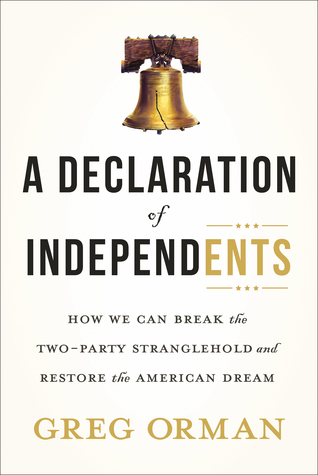A declaration of independents
The Lantern reviews Greg Orman’s novel about how to repair today’s politics
One of our first speakers at American Legion Boy’s State (300 boys from around Minnesota form the Minnesota Government for a week) was Greg Orman. He grew up in Minnesota, went to Boy’s State when he was a kid, and was selected to go to Boys’ Nation and became president. At that time he was able to shake hands with President Reagan. That is an honor that very few high school students get. He continues his speech, and lands at the problems facing our society today – the political divide. This is why he ran for Senate as an Independent. Unfortunately he lost, but the lessons he learned were put in A Declaration of Independents. he explains how in his opinion our politics got so screwed up in the first place and how to fix it. Today more than ever, Americans are polarized from one another. We aren’t getting the solutions we need to face the 21st century problems that we have. After his riveting speech, I felt compelled to go up there and shake his hand.
Before Boy’s State I thought everybody that wasn’t a republican was out to destroy America. I was a victim of the two party system, in which we throw ourselves at each other, and believe that half of the country is out to destroy what we hold dearly. America is not a black and white country. After Boy’s State I stayed true to my Conservative values, but I no longer see Liberals as the problem. The problem is the Washington Elite, and the polarization of our parties. A Declaration of Independents gets to the core of these problems while still being cheap – at only $9.54 – and an easy read without the jargon that usually follows politics.
The book follows a logical outline that frames Orman’s argument about the corrupt Washington Elite and the polarization of this nation. He starts by implementing the facts of our current situation – like how fifty percent of those who are elected in Washington stay in D.C. as lobbyists, whereas in the 80s the percentage was only five fifteen percent. Also our parties now follow more along ideological lines: In the 70s there were Conservative Dixiecrats and Liberal Western Republicans. Now compromise cannot happen as it once did because of this new division.
Orman then continues about how we have gotten there, and how learning from our past can help us fix the problem, which he concludes is a break away from the two party system. Orman creates a strong argument in which to vote independent: Parties no longer represent the people, both are hypocritical in nature and after campaign finance laws were relaxed focused on fundraising for reelection instead of getting the will of the electorate done.
One thing prevented me from hopping on the independent train, and that was the fact that both the Republican and Democratic parties are not a complete stain on America. As James Madison writes in Federalist Paper #10, “…faction[Political Parties are thus sown in the nature of man.”
Throwing away our two party system is a slight fantasy, and even if that wish came through, another faction system would take it’s place. Humans are prone to grouping into communities with shared interests. The only way to throw off the shackles of our two party system is to believe the American populace has the above-human characteristic to not faction again. But men are not Angels, and neither are Americans.
The book was an enlightening read. There are problems with our two party system that need to be fixed, and we do need to declare independence from the Washington elite – but until we can figure out a system that doesn’t continually faction our society as a whole, we’re going to be stuck with Republicans and Democrats for the foreseeable future.

Taking on Tenth grade, trap shooting, speech, skiing, jazz band, band and debate keeps Grant extra busy during the school year. Plus, he's the Lantern's...

